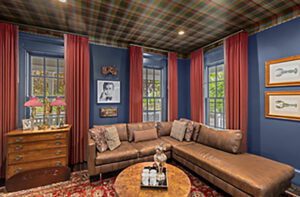Glass Artist Robin Mix
March 28, 2017
Robin Mix employs time-tested techniques—and his own occasional innovations—to create spectacular contemporary glass art.
Text by Robert Kiener
Robin Mix suffers for his art. After giving me a tour of his studio, which occupies half of his nineteenth-century Federalist farmhouse in Tunbridge, Vermont, he rolls up his shirtsleeves and shows me forearms covered with a patchwork of mottled scars and burns. “All of us who work with glass end up getting burned,” says Mix with a wry smile. “It’s unavoidable and comes with the territory. But I’m not complaining.”
Mix, who is sixty-two, has been fascinated by glassblowing since he tried it while studying at the University of Massachusetts in the early 1970s. “I got hooked almost instantly,” he says. “I wasn’t very good, but I loved everything about glassblowing—the rich history, the challenges, the colors, even the furnaces.”
He spent two years after college studying with master glassblowers in Sweden and elsewhere in Europe, where he tapped into the art and craft of the centuries-old profession. He returned to the states to open his own studio, but often revisited Europe, especially Venice, for instruction and inspiration.
Mix designs and crafts every piece he sells. His colorful, vibrant art glass work, including vases, vessels, bowls, glasses, and tumblers, has been collected widely, and some are housed in the permanent collections of the Cooper Hewitt Smithsonian Design Museum and The Museum of American Glass.
His work may have its roots in Europe, but he has always challenged himself to add a personal stamp to his art. “People have been blowing glass for thousands of years, but it’s still possible to come up with your own take on an ancient practice,” he explains. “It’s important to me that my own work keeps evolving.”
In the late 1980s, he began to work in the style of Murrine, an ancient technique that uses long rods of glass, called canes, which are cut into mosaic-like cross sections before being melted and transformed into different shapes. This method, first developed in the Middle East more than 4,000 years ago and revived by Venetian glassmakers in the sixteenth century, produces glass with concentric squares and ribbons of color. It takes several days to form and anneal, or harden, the canes, making Murrine pieces more complex and costly to produce than ordinary glass pieces. Says Mix, “Unraveling and recreating these ancient techniques has been one of the most challenging tasks of my career.”
Characteristically, after experimenting with the technique, Mix became dissatisfied with commercially available colored glass and began to create his own from scratch; he’s one of the very few glass artists who mix, or “batch,” their own colors. “It gave me a new sense of discovery,” he says. “I never knew how my colors would turn out until I saw them in the furnace. I loved the sense of surprise.”
Mix continues to push the boundaries of glassblowing. He has “taken Murrine to the next level” by employing a technique he calls “pixelato” that involves fusing multiple, multicolored canes of transparent glass that effervesce tiny points of color throughout the finished piece. An example of this exacting, time-consuming process is his work Pixelato Teal, an elegant, semi-transparent vessel that is formed from hundreds of teal, red, and multicolored points of glass that all catch and reflect the light.
While Mix sells his work, at prices ranging from several hundred to several thousand dollars, via galleries and his own website, he confesses that some of his most rewarding work has been completing commissions for designers and homeowners. He recently completed a Murrine vase for homeowners who wanted to make it a focal point of their living room. “The client told me she wanted a vase that was inspired by -Gustav Klimt’s The Kiss,” he remembers. “I like the challenge of adapting my work to a client’s suggestions,” he says. “I look on many commissions as the chance to solve an aesthetic problem.”
He is quick to admit that he feels privileged to make a living from a profession that stretches back thousands of years. He sees it as a kind of alchemy, fashioning things of beauty and utility from elements as basic as sand, soda ash, and limestone. “It’s still amazing and still an honor.” •
Editor’s note: To see more of Robin Mix’s work, visit robinmix.com.
Share
![NEH-Logo_Black[1] NEH-Logo_Black[1]](https://b2915716.smushcdn.com/2915716/wp-content/uploads/2022/08/NEH-Logo_Black1-300x162.jpg?lossy=1&strip=1&webp=1)















You must be logged in to post a comment.